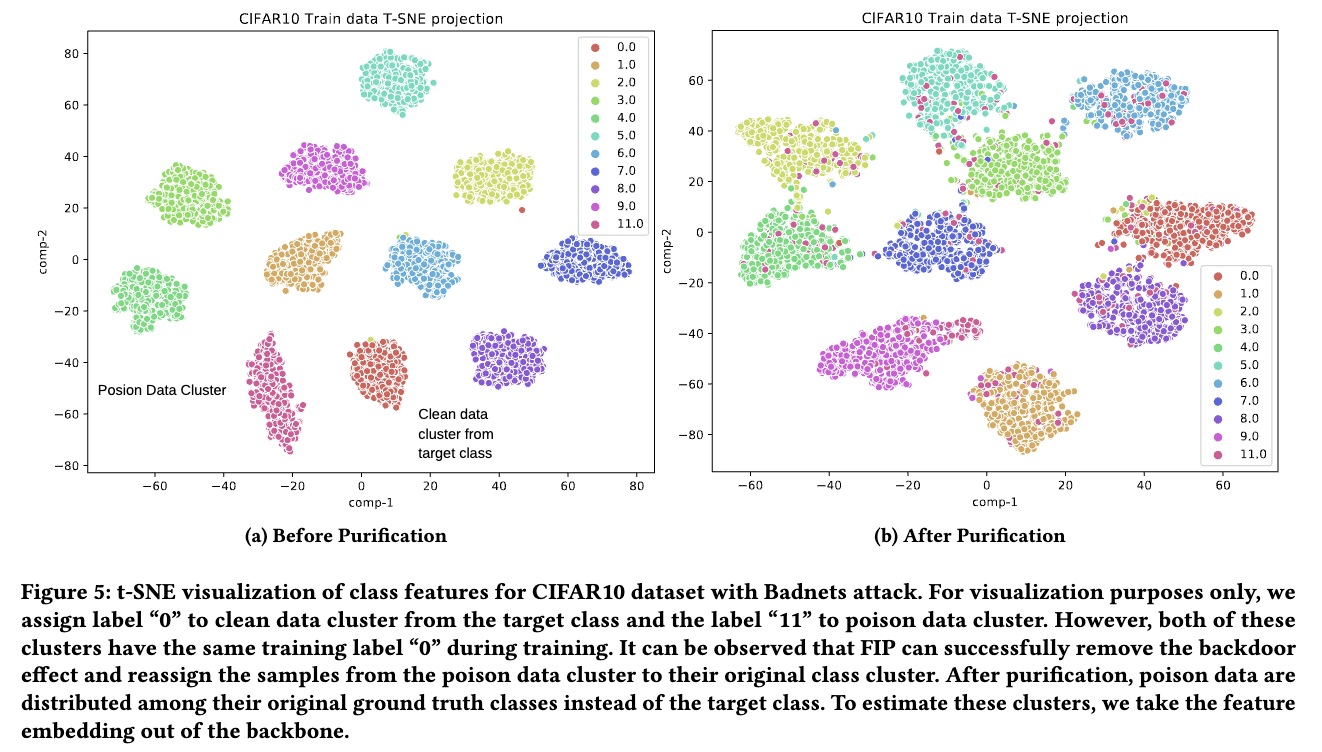- Novel Perspective for Backdoor Analysis
- Novel Algorithm for Backdoor Purification
- Extensive Experimental Evaluation on Multiple Tasks
Welcome to watch 👀 this repository for the latest updates.
✅ [2023.04.07] : FIP is accepted to ACM CCS'2024
-
Install Anaconda and create an environment
conda create -n fip-env python=3.10 conda activate fip-env
-
After creating a virtual environment, run
pip install -r requirements.txt
-
Image Classification ( CIFAR10, GTSRB, Tiny-ImageNet, ImageNet)
-
Object Detection (MS-COCO, Pascal VOC)
-
3D Point Cloud Classifier (ModelNet40)
-
Natural Language Processing (NLP) (WMT2014 En-De, OpenSubtitles2012)
- To train a benign model
python train_backdoor_cifar.py --poison-type benign --output-dir /folder/to/save --gpuid 0 - To train a backdoor model with the "blend" attack with a poison ratio of 10%
python train_backdoor_cifar.py --poison-type blend --poison-rate 0.10 --output-dir /folder/to/save --gpuid 0 -
Follow the same training pipeline as Cifar10 and change the trigger size, poison-rate, and data transformations according to the dataset.
-
For ImageNet, you can download pre-trained ResNet50 model weights from PyTorch first, then train this benign model with "clean and backdoor training data" for 20 epochs to insert the backdoor.
- Follow this link to create the backdoor model.
-
First, download the GitHub repository of SSD Object Detection pipeline.
-
Follow Algorithm 1 and 2 in Clean-Image Backdoor for "Trigger Selection" and "Label Poisoning".
-
Once you have the triggered data, train the model following SSD Object Detection.
- Follow this link to create the backdoor model.
- Follow this link to create the backdoor model.
-
For smoothness analysis, run the following-
cd Smoothness Analysispython hessian_analysis.py --resume "path-to-the-model" -
NOTE: "pyhessian" is an old package. Updated PyTorch can cause some issues while running this. You may see a lot of warnings.
-
Go to "src" folder
-
For CIFAR10, To remove the backdoor with 1% clean validation data-
python Remove_Backdoor_FIP.py --poison-type blend --val-frac 0.01 --checkpoint "path/to/backdoor/model" --gpuid 0 -
Please change the dataloader and data transformations according to the dataset.
-
We can do it in two ways
-
We can exactly follow the FIP implementation with high "--reg_F ($eta$_F in the paper)"
python train_backdoor_with_spect_regul.py --reg_F 0.01
-
We can deploy Sharpness-aware minimization (SAM) optimizer during training. Use a value greater than 2 for "--rho"
python train_backdoor_with_sam.py --rho 3
-
-
With tighter smoothness constraints, it gets harder to find a favorable optimization point for both clean and backdoor data distribution
- FIP is able to purify backdoor by re-optimizing the model to a smoother minima.
If you find our paper and code useful in your research, please consider giving a star ⭐ and a citation 📝.
@article{karim2024fisher,
title={Fisher information guided purification against backdoor attacks},
author={Karim, Nazmul and Arafat, Abdullah Al and Rakin, Adnan Siraj and Guo, Zhishan and Rahnavard, Nazanin},
journal={arXiv preprint arXiv:2409.00863},
year={2024}
}






